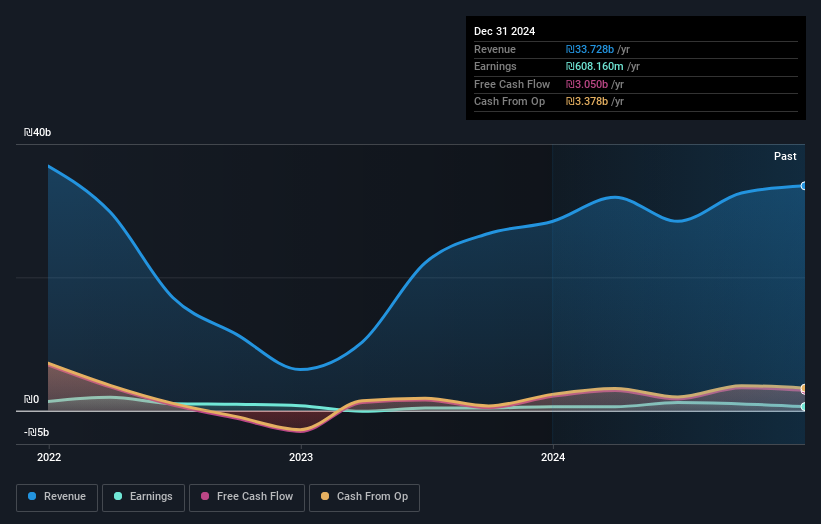While individual investors own 28% of Migdal Insurance and Financial Holdings Ltd. (TLV:MGDL), private companies are its largest shareholders with 55% ownership

Key Insights
- The considerable ownership by private companies in Migdal Insurance and Financial Holdings indicates that they collectively have a greater say in management and business strategy
- 55% of the company is held by a single shareholder (Shlomo Eliahu Holding Ltd.)
- Institutions own 17% of Migdal Insurance and Financial Holdings
If you want to know who really controls Migdal Insurance and Financial Holdings Ltd. (TLV:MGDL), then you'll have to look at the makeup of its share registry. And the group that holds the biggest piece of the pie are private companies with 55% ownership. Put another way, the group faces the maximum upside potential (or downside risk).
Individual investors, on the other hand, account for 28% of the company's stockholders.
In the chart below, we zoom in on the different ownership groups of Migdal Insurance and Financial Holdings.
See our latest analysis for Migdal Insurance and Financial Holdings

What Does The Institutional Ownership Tell Us About Migdal Insurance and Financial Holdings?
Institutional investors commonly compare their own returns to the returns of a commonly followed index. So they generally do consider buying larger companies that are included in the relevant benchmark index.
Migdal Insurance and Financial Holdings already has institutions on the share registry. Indeed, they own a respectable stake in the company. This can indicate that the company has a certain degree of credibility in the investment community. However, it is best to be wary of relying on the supposed validation that comes with institutional investors. They too, get it wrong sometimes. It is not uncommon to see a big share price drop if two large institutional investors try to sell out of a stock at the same time. So it is worth checking the past earnings trajectory of Migdal Insurance and Financial Holdings, (below). Of course, keep in mind that there are other factors to consider, too.

Hedge funds don't have many shares in Migdal Insurance and Financial Holdings. Shlomo Eliahu Holding Ltd. is currently the company's largest shareholder with 55% of shares outstanding. This essentially means that they have extensive influence, if not outright control, over the future of the corporation. With 3.9% and 2.4% of the shares outstanding respectively, Phoenix Excellence Pension and Provident Ltd. and Phoenix Investments & Finances Ltd are the second and third largest shareholders.
Researching institutional ownership is a good way to gauge and filter a stock's expected performance. The same can be achieved by studying analyst sentiments. As far as we can tell there isn't analyst coverage of the company, so it is probably flying under the radar.
Insider Ownership Of Migdal Insurance and Financial Holdings
The definition of company insiders can be subjective and does vary between jurisdictions. Our data reflects individual insiders, capturing board members at the very least. The company management answer to the board and the latter should represent the interests of shareholders. Notably, sometimes top-level managers are on the board themselves.
Most consider insider ownership a positive because it can indicate the board is well aligned with other shareholders. However, on some occasions too much power is concentrated within this group.
Our most recent data indicates that insiders own less than 1% of Migdal Insurance and Financial Holdings Ltd.. However, it's possible that insiders might have an indirect interest through a more complex structure. It is a pretty big company, so it would be possible for board members to own a meaningful interest in the company, without owning much of a proportional interest. In this case, they own around ₪310k worth of shares (at current prices). It is always good to see at least some insider ownership, but it might be worth checking if those insiders have been selling.
General Public Ownership
The general public-- including retail investors -- own 28% stake in the company, and hence can't easily be ignored. This size of ownership, while considerable, may not be enough to change company policy if the decision is not in sync with other large shareholders.
Private Company Ownership
We can see that Private Companies own 55%, of the shares on issue. Private companies may be related parties. Sometimes insiders have an interest in a public company through a holding in a private company, rather than in their own capacity as an individual. While it's hard to draw any broad stroke conclusions, it is worth noting as an area for further research.
Next Steps:
While it is well worth considering the different groups that own a company, there are other factors that are even more important.
I like to dive deeper into how a company has performed in the past. You can access this interactive graph of past earnings, revenue and cash flow, for free.
Of course, you might find a fantastic investment by looking elsewhere. So take a peek at this free list of interesting companies.
NB: Figures in this article are calculated using data from the last twelve months, which refer to the 12-month period ending on the last date of the month the financial statement is dated. This may not be consistent with full year annual report figures.
New: Manage All Your Stock Portfolios in One Place
We've created the ultimate portfolio companion for stock investors, and it's free.
• Connect an unlimited number of Portfolios and see your total in one currency
• Be alerted to new Warning Signs or Risks via email or mobile
• Track the Fair Value of your stocks
Have feedback on this article? Concerned about the content? Get in touch with us directly. Alternatively, email editorial-team (at) simplywallst.com.
This article by Simply Wall St is general in nature. We provide commentary based on historical data and analyst forecasts only using an unbiased methodology and our articles are not intended to be financial advice. It does not constitute a recommendation to buy or sell any stock, and does not take account of your objectives, or your financial situation. We aim to bring you long-term focused analysis driven by fundamental data. Note that our analysis may not factor in the latest price-sensitive company announcements or qualitative material. Simply Wall St has no position in any stocks mentioned.
About TASE:MGDL
Migdal Insurance and Financial Holdings
Provides insurance, pension, and financial services for private and corporate customers in Israel.
Excellent balance sheet and slightly overvalued.
Similar Companies
Market Insights
Community Narratives



